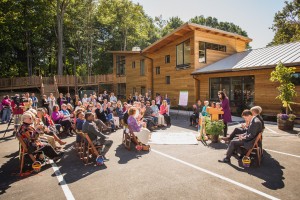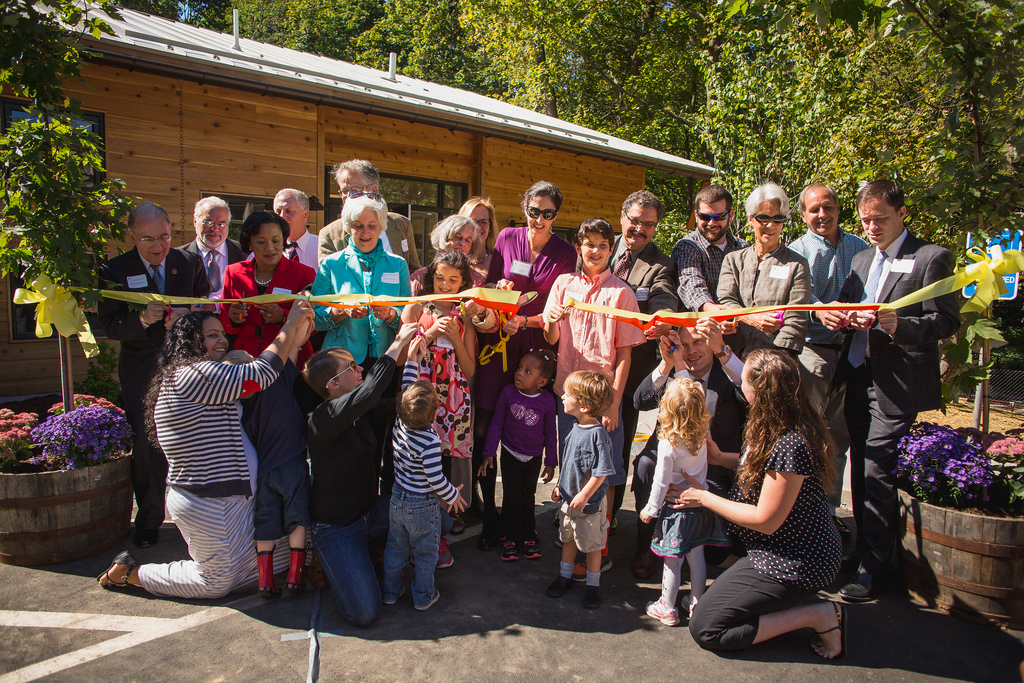
No one cries over spilt milk at the Friends Center for Children. The Tupperware has tops there. Everyone always remains calm.
A small boy reaches for the Puffins cereal and frozen blueberries sitting in the center of a low table. He pours them into a neon yellow bowl, and turns to three other boys at the table. They watch their peers stack blocks, curl up with books, and fiddle with puzzle pieces. Then one boy reaches for the Lazy Susan and gives it a whirl. Containers of milk and raisins are upended. Fluorescent cutlery goes flying.
What looks to be a playtime mess is part of an attempt to clean up early childhood education in New Haven. The Friends Center for Children, a progressive Quaker pre-school in Fair Haven, began with four children in a basement and today educates more than seventy toddlers and infants in a new state-of-the-art facility. The 9,245-square-foot building was completed just this year, but is already well on its way to serving the community.
When the center first opened in 2007, local families with young children were severely underserved. New Haven Mayor John DeStefano had formed a group of early childhood educators, administrators, and community leaders to develop an education plan for the city’s youngest children. With over a third of children under the age of five living below the poverty line, low-income families were the focus of their discussion. When the Friends Center announced its decision to expand to a K-8 school, representatives from the city urged a different direction. According to board member Greg Moschetti, many approached the board with the same plea: “Please, please take care of our babies.”
In 2009, they embarked on a campaign to build a new home for the center. The school needed a space that could allow for growth but still maintain the sense of community and intimacy that had led families to line up on their waiting list. The Quaker congregation donated a plot of land behind its building to form what would become the independently-run Friends Center for Children. After a three-year wait, Connecticut approved a $1,750,000 bond to fund the center’s construction in June of last year. Work progressed quickly over the spring and summer; the children watched backhoes and frontloaders move in and out of their backyard.
On the September morning that I arrive at the center, all is quiet, the cacophony of construction now absent. An unassuming wood and glass façade peeks out from behind the dark brown, two-story Quaker meeting house. The obtuse angles and metal paneling of its roof distinguish it from the quaint twentieth-century mill houses on the street. The building, I learn later, was built to gold-level LEED certification, with walls made from local cedar wood, a geothermal heating system, and a rooftop garden.

Today is the new building’s grand opening. In the parking lot between the school and East Grand Street, rows of chairs face a big red and yellow ribbon strung across the front of the center. It is still early, and Greg Moschetti arrives before the crowd. Though Moschetti is a member of the founding board, he doesn’t think of himself that way. “I would rather think of the original small band of Quakers in the lower level of the meeting house as conveners,” he says. “We convened a conversation that will continue for years and years to come, as the Friends Center leads the way in early-childhood education.”
That conversation is mainly concerned with keeping high-quality childcare affordable. Around two-thirds of the center’s students live in households earning less than the state’s median income of $54,000; its average annual tuition is $7706 a year. Early childhood education is expensive: the hours are long in order to accommodate the schedules of working parents, and the state mandates high caregiver-to-child ratios. While Head Start and New Haven’s magnet school pre-K programs offer a free alternative for students from low-income families, spots are limited. At the Friends Center, parent volunteers and a great deal of administrative legwork allows the school to calculate tuition on a sliding scale. The center covers the difference between tuition money and the operating costs using what Schiavone says is a “jigsaw puzzle of public funds, foundation grants, and private donors.”
As a crowd gathers in the parking lot, I meet Michael Anderson, an employee at the Peabody Museum and another founder of the Friends Center. He tells me that back when the childcare program was in the planning stage, he suggested a co-op program, which the other founders embraced. Every parent volunteers for an hour and a half each week, with some adjustments based on the number of children parents enrolled. Some help out in the classroom, while others do laundry on weekends. Arie Mobley, a postdoctoral candidate at a neurosurgery lab, spends her volunteer hours serving on the board. Her husband, a carpenter, uses his skills to build furniture for the center.
In some small way, each of these parents is addressing a national call to narrowing the achievement gap between kids from low- and high-income families. Across the country, studies by universities, private foundations, and NGOs point to early childhood as a crucial period in a child’s development. The Center’s efforts are part of a national conversation. In his 2013 State of the Union address, President Barack Obama said, “In states that made it a priority to educate our youngest children…students grow up more likely to read and do math at grade level, graduate high school, hold a job, form more stable families of their own. We know this works. So let’s do what works and make sure none of our children start the race of life already behind.”
Moschetti envisions Quaker schools playing an important part in this process. As one of the four Quaker members on the school’s fourteen-person board, Moschetti was instrumental in shaping the school’s mission in its early days. He emphasizes that Quaker values will continue to shape the school, excitedly pointing out that there are already measures in place to remind students and teachers at the Friends Center of their roots. Each of the classroom doors is labeled with a different Quaker value: Peace, Community, Equality, Truth, and Simplicity.
Many share his optimism. At the ribbon cutting, graduates of the original basement preschool stream in, as do parents, mayoral candidates, and neighbors. Passing by a white press tent, they settle into seats set up in front of the Friends Center door. A large easel with lined white paper displays the agenda in large, curly handwriting. Brightly-colored buckets filled with scissors sit at the end of each row of chairs. Then a line of preschoolers, holding hands, emerges from the playground gate. The crowd quiets as they watch the children find their seats—right in front.

